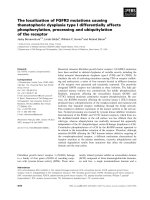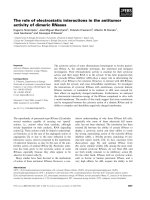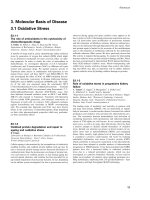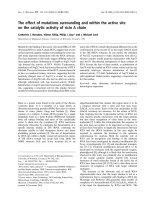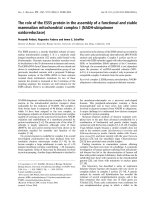Báo cáo khoa học: "The utility of parse-derived features for automatic discourse segmentation" doc
Bạn đang xem bản rút gọn của tài liệu. Xem và tải ngay bản đầy đủ của tài liệu tại đây (166.74 KB, 8 trang )
Proceedings of the 45th Annual Meeting of the Association of Computational Linguistics, pages 488–495,
Prague, Czech Republic, June 2007.
c
2007 Association for Computational Linguistics
The utility of parse-derived features for automatic discourse segmentation
Seeger Fisher and Brian Roark
Center for Spoken Language Understanding, OGI School of Science & Engineering
Oregon Health & Science University, Beaverton, Oregon, 97006 USA
{fishers,roark}@cslu.ogi.edu
Abstract
We investigate different feature sets for
performing automatic sentence-level dis-
course segmentation within a general ma-
chine learning approach, including features
derived from either finite-state or context-
free annotations. We achieve the best re-
ported performance on this task, and demon-
strate that our SPADE-inspired context-free
features are critical to achieving this level of
accuracy. This counters recent results sug-
gesting that purely finite-state approaches
can perform competitively.
1 Introduction
Discourse structure annotations have been demon-
strated to be of high utility for a number of NLP
applications, including automatic text summariza-
tion (Marcu, 1998; Marcu, 1999; Cristea et al.,
2005), sentence compression (Sporleder and Lap-
ata, 2005), natural language generation (Prasad et
al., 2005) and question answering (Verberne et al.,
2006). These annotations include sentence segmen-
tation into discourse units along with the linking
of discourse units, both within and across sentence
boundaries, into a labeled hierarchical structure. For
example, the tree in Figure 1 shows a sentence-level
discourse tree for the string “Prices have dropped but
remain quite high, according to CEO Smith,” which
has three discourse segments, each labeled with ei-
ther “Nucleus” or “Satellite” depending on how cen-
tral the segment is to the coherence of the text.
There are a number of corpora annotated with
discourse structure, including the well-known RST
Treebank (Carlson et al., 2002); the Discourse
GraphBank (Wolf and Gibson, 2005); and the Penn
Discourse Treebank (Miltsakaki et al., 2004). While
the annotation approaches differ across these cor-
pora, the requirement of sentence segmentation into
Root
✟
✟
✟
✟
✟
✟
❍
❍
❍
❍
❍
❍
Nucleus
✟
✟
✟
✟
✟
❍
❍
❍
❍
❍
Nucleus
✏
✏
✏
✏
Prices have dropped
Satellite
✏
✏
✏
✏
but remain quite high
Satellite
✏
✏
✏
✏
✏
according to CEO Smith
Figure 1: Example Nucleus/Satellite labeled sentence-level
discourse tree.
sub-sentential discourse units is shared across all ap-
proaches. These resources have facilitated research
into stochastic models and algorithms for automatic
discourse structure annotation in recent years.
Using the RST Treebank as training and evalua-
tion data, Soricut and Marcu (2003) demonstrated
that their automatic sentence-level discourse pars-
ing system could achieve near-human levels of ac-
curacy, if it was provided with manual segmenta-
tions and manual parse trees. Manual segmenta-
tion was primarily responsible for this performance
boost over their fully automatic system, thus mak-
ing the case that automatic discourse segmentation is
the primary impediment to high accuracy automatic
sentence-level discourse structure annotation. Their
models and algorithm – subsequently packaged to-
gether into the publicly available SPADE discourse
parser
1
– make use of the output of the Charniak
(2000) parser to derive syntactic indicator features
for segmentation and discourse parsing.
Sporleder and Lapata (2005) also used the RST
Treebank as training data for data-driven discourse
parsing algorithms, though their focus, in contrast
to Soricut and Marcu (2003), was to avoid context-
free parsing and rely exclusively on features in their
model that could be derived via finite-state chunkers
and taggers. The annotations that they derive are dis-
1
/>488
course “chunks”, i.e., sentence-level segmentation
and non-hierarchical nucleus/span labeling of seg-
ments. They demonstrate that their models achieve
comparable results to SPADE without the use of any
context-free features. Once again, segmentation is
the part of the process where the automatic algo-
rithms most seriously underperform.
In this paper we take up the question posed by
the results of Sporleder and Lapata (2005): how
much, if any, accuracy reduction should we expect
if we choose to use only finite-state derived fea-
tures, rather than those derived from full context-
free parses? If little accuracy is lost, as their re-
sults suggest, then it would make sense to avoid rel-
atively expensive context-free parsing, particularly
if the amount of text to be processed is large or if
there are real-time processing constraints on the sys-
tem. If, however, the accuracy loss is substantial,
one might choose to avoid context-free parsing only
in the most time-constrained scenarios.
While Sporleder and Lapata (2005) demonstrated
that their finite-state system could perform as well as
the SPADE system, which uses context-free parse
trees, this does not directly answer the question of
the utility of context-free derived features for this
task. SPADE makes use of a particular kind of fea-
ture from the parse trees, and does not train a gen-
eral classifier making use of other features beyond
the parse-derived indicator features. As we shall
show, its performance is not the highest that can be
achieved via context-free parser derived features.
In this paper, we train a classifier using a gen-
eral machine learning approach and a range of finite-
state and context-free derived features. We investi-
gate the impact on discourse segmentation perfor-
mance when one feature set is used versus another,
in such a way establishing the utility of features de-
rived from context-free parses. In the course of so
doing, we achieve the best reported performance on
this task, an absolute F-score improvement of 5.0%
over SPADE, which represents a more than 34% rel-
ative error rate reduction.
By focusing on segmentation, we provide an ap-
proach that is generally applicable to all of the
various annotation approaches, given the similari-
ties between the various sentence-level segmenta-
tion guidelines. Given that segmentation has been
shown to be a primary impediment to high accu-
racy sentence-level discourse structure annotation,
this represents a large step forward in our ability to
automatically parse the discourse structure of text,
whatever annotation approach we choose.
2 Methods
2.1 Data
For our experiments we use the Rhetorical Structure
Theory Discourse Treebank (Carlson et al., 2002),
which we will denote RST-DT, a corpus annotated
with discourse segmentation and relations according
to Rhetorical Structure Theory (Mann and Thomp-
son, 1988). The RST-DT consists of 385 docu-
ments from the Wall Street Journal, about 176,000
words, which overlaps with the Penn Wall St. Jour-
nal (WSJ) Treebank (Marcus et al., 1993).
The segmentation of sentences in the RST-DT
is into clause-like units, known as elementary dis-
course units, or edus. We will use the two terms
‘edu’ and ‘segment’ interchangeably throughout the
rest of the paper. Human agreement for this segmen-
tation task is quite high, with agreement between
two annotators at an F-score of 98.3 for unlabeled
segmentation (Soricut and Marcu, 2003).
The RST-DT corpus annotates edu breaks, which
typically include sentence boundaries, but sentence
boundaries are not explicitly annotated in the corpus.
To perform sentence-level processing and evalua-
tion, we aligned the RST-DT documents to the same
documents in the Penn WSJ Treebank, and used the
sentence boundaries from that corpus.
2
An addi-
tional benefit of this alignment is that the Penn WSJ
Treebank tokenization is then available for parsing
purposes. Simple minimum edit distance alignment
effectively allowed for differences in punctuation
representation (e.g., double quotes) and tokenization
when deriving the optimal alignment.
The RST-DT corpus is partitioned into a train-
ing set of 347 documents and a test set of 38 doc-
uments. This test set consists of 991 sentences with
2,346 segments. For training purposes, we created
a held-out development set by selecting every tenth
sentence of the training set. This development set
was used for feature development and for selecting
the number of iterations used when training models.
2.2 Evaluation
Previous research into RST-DT segmentation and
parsing has focused on subsets of the 991 sentence
test set during evaluation. Soricut and Marcu (2003)
2
A small number of document final parentheticals are in the
RST-DT and not in the Penn WSJ Treebank, which our align-
ment approach takes into account.
489
omitted sentences that were not exactly spanned by
a subtree of the treebank, so that they could fo-
cus on sentence-level discourse parsing. By our
count, this eliminates 40 of the 991 sentences in the
test set from consideration. Sporleder and Lapata
(2005) went further and established a smaller sub-
set of 608 sentences, which omitted sentences with
only one segment, i.e., sentences which themselves
are atomic edus.
Since the primary focus of this paper is on seg-
mentation, there is no strong reason to omit any sen-
tences from the test set, hence our results will eval-
uate on all 991 test sentences, with two exceptions.
First, in Section 2.3, we compare SPADE results un-
der our configuration with results from Sporleder
and Lapata (2005) in order to establish compara-
bility, and this is done on their 608 sentence sub-
set. Second, in Section 3.2, we investigate feed-
ing our segmentation into the SPADE system, in or-
der to evaluate the impact of segmentation improve-
ments on their sentence-level discourse parsing per-
formance. For those trials, the 951 sentence subset
from Soricut and Marcu (2003) is used. All other
trials use the full 991 sentence test set.
Segmentation evaluation is done with precision,
recall and F1-score of segmentation boundaries.
Given a word string w
1
. . . w
k
, we can index word
boundaries from 0 to k, so that each word w
i
falls
between boundaries i−1 and i. For sentence-based
segmentation, indices 0 and k, representing the be-
ginning and end of the string, are known to be seg-
ment boundaries. Hence Soricut and Marcu (2003)
evaluate with respect to sentence internal segmenta-
tion boundaries, i.e., with indices j such that 0<j<k
for a sentence of length k. Let g be the number
of sentence-internal segmentation boundaries in the
gold standard, t the number of sentence-internal seg-
mentation boundaries in the system output, and m
the number of correct sentence-internal segmenta-
tion boundaries in the system output. Then
P =
m
t
R =
m
g
and F 1 =
2P R
P +R
=
2m
g+t
In Sporleder and Lapata (2005), they were pri-
marily interested in labeled segmentation, where the
segment initial boundary was labeled with the seg-
ment type. In such a scenario, the boundary at in-
dex 0 is no longer known, hence their evaluation in-
cluded those boundaries, even when reporting un-
labeled results. Thus, in section 2.3, for compar-
ison with reported results in Sporleder and Lapata
(2005), our F1-score is defined accordingly, i.e., seg-
Segmentation system F1
Sporleder and Lapata best (reported) 88.40
SPADE
Sporleder and Lapata configuration (reported): 87.06
current configuration: 91.04
Table 1: Segmentation results on the Sporleder and Lapata
(2005) data set, with accuracy defined to include sentence initial
segmentation boundaries.
mentation boundaries j such that 0 ≤ j < k.
In addition, we will report unlabeled bracketing
precision, recall and F1-score, as defined in the
PARSEVAL metrics (Black et al., 1991) and eval-
uated via the widely used evalb package. We also
use evalb when reporting labeled and unlabeled dis-
course parsing results in Section 3.2.
2.3 Baseline SPADE setup
The publicly available SPADE package, which en-
codes the approach in Soricut and Marcu (2003),
is taken as the baseline for this paper. We made
several modifications to the script from the default,
which account for better baseline performance than
is achieved with the default configuration. First, we
modified the script to take given parse trees as input,
rather than running the Charniak parser itself. This
allowed us to make two modifications that improved
performance: turning off tokenization in the Char-
niak parser, and reranking. The default script that
comes with SPADE does not turn off tokenization
inside of the parser, which leads to degraded perfor-
mance when the input has already been tokenized in
the Penn Treebank style. Secondly, Charniak and
Johnson (2005) showed how reranking of the 50-
best output of the Charniak (2000) parser gives sub-
stantial improvements in parsing accuracy. These
two modifications to the Charniak parsing output
used by the SPADE system lead to improvements
in its performance compared to previously reported
results.
Table 1 compares segmentation results of three
systems on the Sporleder and Lapata (2005) 608
sentence subset of the evaluation data: (1) their best
reported system; (2) the SPADE system results re-
ported in that paper; and (3) the SPADE system re-
sults with our current configuration. The evaluation
uses the unlabeled F1 measure as defined in that pa-
per, which counts sentence initial boundaries in the
scoring, as discussed in the previous section. As can
be seen from these results, our improved configu-
ration of SPADE gives us large improvements over
the previously reported SPADE performance on this
subset. As a result, we feel that we can use SPADE
490
as a very strong baseline for evaluation on the entire
test set.
Additionally, we modified the SPADE script to al-
low us to provide our segmentations to the full dis-
course parsing that it performs, in order to evalu-
ate the improvements to discourse parsing yielded
by any improvements to segmentation.
2.4 Segmentation classifier
For this paper, we trained a binary classifier, which
was applied independently at each word w
i
in the
string w
1
. . . w
k
, to decide whether that word is the
last in a segment. Note that w
k
is the last word in
the string, and is hence ignored. We used a log-
linear model with no Markov dependency between
adjacent tags,
3
and trained the parameters of the
model with the perceptron algorithm, with averag-
ing to control for over-training (Collins, 2002).
Let C={E, I} be the set of classes: seg-
mentation boundary (E) or non-boundary (I). Let
f(c, i, w
1
. . . w
k
) be a function that takes as in-
put a class value c, a word index i and the word
string w
1
. . . w
k
and returns a d-dimensional vector
of feature values for that word index in that string
with that class. For example, one feature might be
(c = E, w
i
= the), which returns the value 1 when
c = E and the current word is ‘the’, and returns
0 otherwise. Given a d-dimensional parameter vec-
tor φ, the output of the classifier is that class which
maximizes the dot product between the feature and
parameter vectors:
ˆc(i, w
1
. . . w
k
) = argmax
c∈C
φ · f(c, i, w
1
. . . w
k
) (1)
In training, the weights in φ are initialized to 0.
For m epochs (passes over the training data), for
each word in the training data (except sentence final
words), the model is updated. Let i be the current
word position in string w
1
. . . w
k
and suppose that
there have been j−1 previous updates to the model
parameters. Let ¯c
i
be the true class label, and let ˆc
i
be shorthand for ˆc(i, w
1
. . . w
k
) in equation 1. Then
the parameter vector φ
j
at step j is updated as fol-
lows:
φ
j
= φ
j−1
− f(ˆc, i, w
1
. . . w
k
) + f (¯c, i, w
1
. . . w
k
) (2)
As stated in Section 2.1, we reserved every tenth
sentence as held-out data. After each pass over the
training data, we evaluated the system performance
3
Because of the sparsity of boundary tags, Markov depen-
dencies between tags buy no additional system accuracy.
on this held-out data, and chose the model that op-
timized accuracy on that set. The averaged percep-
tron was used on held-out and evaluation sets. See
Collins (2002) for more details on this approach.
2.5 Features
To tease apart the utility of finite-state derived fea-
tures and context-free derived features, we consider
three feature sets: (1) basic finite-state features; (2)
context-free features; and (3) finite-state approxima-
tion to context-free features. Note that every feature
must include exactly one class label c in order to
discriminate between classes in equation 1. Hence
when presenting features, it can be assumed that the
class label is part of the feature, even if it is not ex-
plicitly mentioned.
The three feature sets are not completely disjoint.
We include simple position-based features in every
system, defined as follows. Because edus are typi-
cally multi-word strings, it is less likely for a word
near the beginning or end of a sentence to be at an
edu boundary. Thus it is reasonable to expect the
position within a sentence of a token to be a helpful
feature. We created 101 indicator features, repre-
senting percentages from 0 to 100. For a string of
length k, at position i, we round i/k to two decimal
places and provide a value of 1 for the corresponding
quantized position feature and 0 for the other posi-
tion features.
2.5.1 Basic finite-state features
Our baseline finite-state feature set includes simple
tagger derived features, as well as features based on
position in the string and n-grams
4
. We annotate
tag sequences onto the word sequence via a compet-
itive discriminatively trained tagger (Hollingshead
et al., 2005), trained for each of two kinds of tag
sequences: part-of-speech (POS) tags and shallow
parse tags. The shallow parse tags define non-
hierarchical base constituents (“chunks”), as defined
for the CoNLL-2000 shared task (Tjong Kim Sang
and Buchholz, 2000). These can either be used
as tag or chunk sequences. For example, the tree
in Figure 2 represents a shallow (non-hierarchical)
parse tree, with four base constituents. Each base
constituent X begins with a word labeled with B
X
,
which signifies that this word begins the constituent.
All other words within a constituent X are labeled
4
We tried using a list of 311 cue phrases from Knott (1996)
to define features, but did not derive any system improvement
through this list, presumably because our simple n-gram fea-
tures already capture many such lexical cues.
491
ROOT
✏
✏
✏
✏
✏
✏
✏
✏
✏
❅
❅
❅
NP
✟
✟
❍
❍
B
NP
DT
the
I
NP
NN
broker
VP
✟
✟
❍
❍
B
VP
MD
will
I
VP
VBD
sell
NP
✟
✟
❍
❍
B
NP
DT
the
I
NP
NNS
stocks
NP
B
NP
NN
tomorrow
Figure 2: Tree representation of shallow parses, with B(egin)
and I(nside) tags
I
X
, and words outside of any base constituent are la-
beled O. In such a way, each word is labeled with
both a POS-tag and a B/I/O tag.
For our three sequences (lexical, POS-tag and
shallow tag), we define n-gram features surround-
ing the potential discourse boundary. If the current
word is w
i
, the hypothesized boundary will occur
between w
i
and w
i+1
. For this boundary position,
the 6-gram including the three words before and the
three words after the boundary is included as a fea-
ture; additionally, all n-grams for n < 6 such that
either w
i
or w
i+1
(or both) is in the n-gram are in-
cluded as features. In other words, all n-grams in a
six word window of boundary position i are included
as features, except those that include neither w
i
nor
w
i+1
in the n-gram. The identical feature templates
are used with POS-tag and shallow tag sequences as
well, to define tag n-gram features.
This feature set is very close to that used in
Sporleder and Lapata (2005), but not identical.
Their n-gram feature definitions were different
(though similar), and they made use of cue phrases
from Knott (1996). In addition, they used a rule-
based clauser that we did not. Despite such differ-
ences, this feature set is quite close to what is de-
scribed in that paper.
2.5.2 Context-free features
To describe our context-free features, we first
present how SPADE made use of context-free parse
trees within their segmentation algorithm, since this
forms the basis of our features. The SPADE features
are based on productions extracted from full syntac-
tic parses of the given sentence. The primary feature
for a discourse boundary after word w
i
is based on
the lowest constituent in the tree that spans words
w
m
. . . w
n
such that m ≤ i < n . For example, in
the parse tree schematic in Figure 3, the constituent
labeled with A is the lowest constituent in the tree
whose span crosses the potential discourse bound-
ary after w
i
. The primary feature is the production
A
✏
✏
✏
✏
✏
✏
✏
✏
❅
❅
❅
B
1
. . . B
j−1
✟
✟
✟
❍
❍
❍
C
1
. . . C
n
✟
✟
❍
❍
. . . T
i
w
i
B
j
. . . B
m
Figure 3: Parse tree schematic for describing context-free seg-
mentation features
that expands this constituent in the tree, with the
proposed segmentation boundary marked, which in
this case is: A → B
1
. . . B
j−1
||B
j
. . . B
m
, where
|| denotes the segmentation boundary. In SPADE,
the production is lexicalized by the head words of
each constituent, which are determined using stan-
dard head-percolation techniques. This feature is
used to predict a boundary as follows: if the relative
frequency estimate of a boundary given the produc-
tion feature in the corpus is greater than 0.5, then a
boundary is predicted; otherwise not. If the produc-
tion has not been observed frequently enough, the
lexicalization is removed and the relative frequency
of a boundary given the unlexicalized production is
used for prediction. If the observations of the unlex-
icalized production are also too sparse, then only the
children adjacent to the boundary are maintained in
the feature, e.g., A → ∗B
j−1
||B
j
∗ where ∗ repre-
sents zero or more categories. Further smoothing is
used when even this is unobserved.
We use these features as the starting point for our
context-free feature set: the lexicalized production
A → B
1
. . . B
j−1
||B
j
. . . B
m
, as defined above for
SPADE, is a feature in our model, as is the unlexi-
calized version of the production. As with the other
features that we have described, this feature is used
as an indicator feature in the classifier applied at the
word w
i
preceding the hypothesized boundary. In
addition to these full production features, we use the
production with only children adjacent to the bound-
ary, denoted by A → ∗B
j−1
||B
j
∗. This production
is used in four ways: fully lexicalized; unlexicalized;
only category B
j−1
lexicalized; and only category
B
j
lexicalized. We also use A → ∗B
j−2
B
j−1
||∗
and A → ∗||B
j
B
j+1
∗ features, both unlexicalized
and with the boundary-adjacent category lexical-
ized. If there is no category B
j−2
or B
j+1
, they are
replaced with “N/A”.
In addition to these features, we fire the same fea-
tures for all productions on the path from A down
492
Segment Boundary accuracy Bracketing accuracy
Segmentation system Recall Precision F1 Recall Precision F1
SPADE 85.4 85.5 85.5 77.7 77.9 77.8
Classifier: Basic finite-state 81.5 83.3 82.4 73.6 74.5 74.0
Classifier: Full finite-state 84.1 87.9 86.0 78.0 80.0 79.0
Classifier: Context-free 84.7 91.1 87.8 80.3 83.7 82.0
Classifier: All features 89.7 91.3 90.5 84.9 85.8 85.3
Table 2: Segmentation results on all 991 sentences in the RST-DT test set. Segment boundary accuracy is for sentence internal
boundaries only, following Soricut and Marcu (2003). Bracketing accuracy is for unlabeled flat bracketing of the same segments.
While boundary accuracy correctly depicts segmentation results, the harsher flat bracketing metric better predicts discourse parsing
performance.
to the word w
i
. For these productions, the seg-
mentation boundary || will occur after all children
in the production, e.g., B
j−1
→ C
1
. . . C
n
||, which
is then used in both lexicalized and unlexicalized
forms. For the feature with only categories adja-
cent to the boundary, we again use “N/A” to denote
the fact that no category occurs to the right of the
boundary: B
j−1
→ ∗C
n
||N/A. Once again, these
are lexicalized as described above.
2.5.3 Finite-state approximation features
An approximation to our context-free features can
be made by using the shallow parse tree, as shown
in Figure 2, in lieu of the full hierarchical parse
tree. For example, if the current word was “sell”
in the tree in Figure 2, the primary feature would
be ROOT → NP VP||NP NP, and it would have an
unlexicalized version and three lexicalized versions:
the category immediately prior to the boundary lex-
icalized; the category immediately after the bound-
ary lexicalized; and both lexicalized. For lexicaliza-
tion, we choose the final word in the constituent as
the lexical head for the constituent. This is a rea-
sonable first approximation, because such typically
left-headed categories as PP and VP lose their argu-
ments in the shallow parse.
As a practical matter, we limit the number of cat-
egories in the flat production to 8 to the left and 8 to
the right of the boundary. In a manner similar to the
n-gram features that we defined in Section 2.5.1, we
allow all combinations with less than 8 contiguous
categories on each side, provided that at least one
of the adjacent categories is included in the feature.
Each feature has an unlexicalized and three lexical-
ized versions, as described above.
3 Experiments
We performed a number of experiments to deter-
mine the relative utility of features derived from
full context-free syntactic parses and those derived
solely from shallow finite-state tagging. Our pri-
mary concern is with intra-sentential discourse seg-
mentation, but we are also interested in how much
the improved segmentation helps discourse parsing.
The syntactic parser we use for all context-free
syntactic parses used in either SPADE or our clas-
sifier is the Charniak parser with reranking, as de-
scribed in Charniak and Johnson (2005). The Char-
niak parser and reranker were trained on the sections
of the Penn Treebank not included in the RST-DT
test set.
All statistical significance testing is done via the
stratified shuffling test (Yeh, 2000).
3.1 Segmentation
Table 2 presents segmentation results for SPADE
and four versions of our classifier. The “Basic finite-
state” system uses only finite-state sequence fea-
tures as defined in Section 2.5.1, while the “Full
finite-state” also includes the finite-state approxima-
tion features from Section 2.5.3. The “Context-free”
system uses the SPADE-inspired features detailed in
Section 2.5.2, but none of the features from Sections
2.5.1 or 2.5.3. Finally, the “All features” section in-
cludes features from all three sections.
5
Note that the full finite-state system is consider-
ably better than the basic finite-state system, demon-
strating the utility of these approximations of the
SPADE-like context-free features. The performance
of the resulting “Full” finite-state system is not sta-
tistically significantly different from that of SPADE
(p=0.193), despite no reliance on features derived
from context-free parses.
The context-free features, however, even without
any of the finite-state sequence features (even lex-
ical n-grams) outperforms the best finite-state sys-
tem by almost two percent absolute, and the sys-
tem with all features improves on the best finite-state
system by over four percent absolute. The system
5
In the “All features” condition, the finite-state approxima-
tion features defined in Section 2.5.3 only include a maximum
of 3 children to the left and right of the boundary, versus a max-
imum of 8 for the “Full finite-state” system. This was found to
be optimal on the development set.
493
Segmentation Unlabeled Nuc/Sat
SPADE 76.9 70.2
Classifier: Full finite state 78.1 71.1
Classifier: All features 83.5 76.1
Table 3: Discourse parsing results on the 951 sentence Sori-
cut and Marcu (2003) evaluation set, using SPADE for parsing,
and various methods for segmentation. Scores are unlabeled
and labeled (Nucleus/Satellite) bracketing accuracy (F1). The
first line shows SPADE performing both segmentation and dis-
course parsing. The other two lines show SPADE performing
discourse parsing with segmentations produced by our classi-
fier using different combinations of features.
with all features is statistically significantly better
than both SPADE and the “Full finite-state” classi-
fier system, at p < 0.001. This large improvement
demonstrates that the context-free features can pro-
vide a very large system improvement.
3.2 Discourse parsing
It has been shown that accurate discourse segmen-
tation within a sentence greatly improves the over-
all parsing accuracy to near human levels (Sori-
cut and Marcu, 2003). Given our improved seg-
mentation results presented in the previous section,
improvements would be expected in full sentence-
level discourse parsing. To achieve this, we modi-
fied the SPADE script to accept our segmentations
when building the fully hierarchical discourse tree.
The results for three systems are presented in Ta-
ble 3: SPADE, our “Full finite-state” system, and
our system with all features. Results for unlabeled
bracketing are presented, along with results for la-
beled bracketing, where the label is either Nucleus
or Satellite, depending upon whether or not the node
is more central (Nucleus) to the coherence of the text
than its sibling(s) (Satellite). This label set has been
shown to be of particular utility for indicating which
segments are more important to include in an auto-
matically created summary or compressed sentence
(Sporleder and Lapata, 2005; Marcu, 1998; Marcu,
1999; Cristea et al., 2005).
Once again, the finite-state system does not
perform statistically significantly different from
SPADE on either labeled or unlabeled discourse
parsing. Using all features, however, results in
greater than 5% absolute accuracy improvement
over both of these systems, which is significant, in
all cases, at p < 0.001.
4 Discussion and future directions
Our results show that context-free parse derived fea-
tures are critical for achieving the highest level of
accuracy in sentence-level discourse segmentation.
Given that edus are by definition clause-like units,
it is not surprising that accurate full syntactic parse
trees provide highly relevant information unavail-
able from finite-state approaches. Adding context-
free features to our best finite-state feature model
reduces error in segmentation by 32.1%, an in-
crease in absolute F-score of 4.5%. These increases
are against a finite-state segmentation model that is
powerful enough to be statistically indistinguishable
from SPADE.
Our experiments also confirm that increased seg-
mentation accuracy yields significantly better dis-
course parsing accuracy, as previously shown to be
the case when providing reference segmentations to
a parser (Soricut and Marcu, 2003). The segmen-
tation reduction in error of 34.5% propagates to a
28.6% reduction in error for unlabeled discourse
parse trees, and a 19.8% reduction in error for trees
labeled with Nucleus and Satellite.
We have several key directions in which to con-
tinue this work. First, given that a general ma-
chine learning approach allowed us to improve upon
SPADE’s segmentation performance, we also be-
lieve that it will prove useful for improving full
discourse parsing, both at the sentence level and
beyond. For efficient inter-sentential discourse
parsing, we see the need for an additional level
of segmentation at the paragraph level. Whereas
most sentences correspond to a well-formed subtree,
Sporleder and Lascarides (2004) report that over
20% of the paragraph boundaries in the RST-DT do
not correspond to a well-formed subtree in the hu-
man annotated discourse parse for that document.
Therefore, to perform accurate and efficient pars-
ing of the RST-DT at the paragraph level, the text
should be segmented into paragraph-like segments
that conform to the human-annotated subtree bound-
aries, just as sentences are segmented into edus.
We also intend to begin work on the other dis-
course annotated corpora. While most work on tex-
tual discourse parsing has made use of the RST-DT
corpus, the Discourse GraphBank corpus provides a
competing annotation that is not constrained to tree
structures (Wolf and Gibson, 2005). Once accurate
levels of segmentation and parsing for both corpora
are attained, it will be possible to perform extrinsic
evaluations to determine their relative utility for dif-
ferent NLP tasks. Recent work has shown promis-
ing preliminary results for recognizing and labeling
relations of GraphBank structures (Wellner et al.,
2006), in the case that the algorithm is provided with
494
manually segmented sentences. Sentence-level seg-
mentation in the GraphBank is very similar to that in
the RST-DT, so our segmentation approach should
work well for Discourse GraphBank style parsing.
The Penn Discourse Treebank (Miltsakaki et al.,
2004), or PDTB, uses a relatively flat annotation of
discourse structure, in contrast to the hierarchical
structures found in the other two corpora. It contains
annotations for discourse connectives and their argu-
ments, where an argument can be as small as a nom-
inalization or as large as several sentences. This ap-
proach obviates the need to create a set of discourse
relations, but sentence internal segmentation is still
a necessary step. Though segmentation in the PDTB
tends to larger units than edus, our approach to seg-
mentation should be straightforwardly applicable to
their segmentation style.
Acknowledgments
Thanks to Caroline Sporleder and Mirella Lapata for
their test data and helpful comments. Thanks also to
Radu Soricut for helpful input. This research was
supported in part by NSF Grant #IIS-0447214. Any
opinions, findings, conclusions or recommendations
expressed in this publication are those of the authors
and do not necessarily reflect the views of the NSF.
References
E. Black, S. Abney, D. Flickenger, C. Gdaniec, R. Grish-
man, P. Harrison, D. Hindle, R. Ingria, F. Jelinek, J. Kla-
vans, M. Liberman, M.P. Marcus, S. Roukos, B. Santorini,
and T. Strzalkowski. 1991. A procedure for quantita-
tively comparing the syntactic coverage of english gram-
mars. In DARPA Speech and Natural Language Workshop,
pages 306–311.
L. Carlson, D. Marcu, and M.E. Okurowski. 2002. RST dis-
course treebank. Linguistic Data Consortium, Catalog #
LDC2002T07. ISBN LDC2002T07.
E. Charniak and M. Johnson. 2005. Coarse-to-fine n-best pars-
ing and MaxEnt discriminative reranking. In Proceedings of
the 43rd Annual Meeting of ACL, pages 173–180.
E. Charniak. 2000. A maximum-entropy-inspired parser. In
Proceedings of the 1st Conference of the North American
Chapter of the Association for Computational Linguistics,
pages 132–139.
M.J. Collins. 2002. Discriminative training methods for hidden
Markov models: Theory and experiments with perceptron
algorithms. In Proceedings of the Conference on Empirical
Methods in Natural Language Processing (EMNLP), pages
1–8.
D. Cristea, O. Postolache, and I. Pistol. 2005. Summarisation
through discourse structure. In 6th International Conference
on Computational Linguistics and Intelligent Text Process-
ing (CICLing).
K. Hollingshead, S. Fisher, and B. Roark. 2005. Comparing
and combining finite-state and context-free parsers. In Pro-
ceedings of HLT-EMNLP, pages 787–794.
A. Knott. 1996. A Data-Driven Methodology for Motivating
a Set of Coherence Relations. Ph.D. thesis, Department of
Artificial Intelligence, University of Edinburgh.
W.C. Mann and S.A. Thompson. 1988. Rhetorical structure
theory: Toward a functional theory of text organization. Text,
8(3):243–281.
D. Marcu. 1998. Improving summarization through rhetorical
parsing tuning. In The 6th Workshop on Very Large Corpora.
D. Marcu. 1999. Discourse trees are good indicators of im-
portance in text. In I. Mani and M. Maybury, editors, Ad-
vances in Automatic Text Summarization, pages 123–136.
MIT Press, Cambridge, MA.
M.P. Marcus, B. Santorini, and M.A. Marcinkiewicz. 1993.
Building a large annotated corpus of English: The Penn
Treebank. Computational Linguistics, 19(2):313–330.
E. Miltsakaki, R. Prasad, A. Joshi, and B. Webber. 2004. The
Penn Discourse TreeBank. In Proceedings of the Language
Resources and Evaluation Conference.
R. Prasad, A. Joshi, N. Dinesh, A. Lee, E. Miltsakaki, and
B. Webber. 2005. The Penn Discourse TreeBank as a re-
source for natural language generation. In Proceedings of
the Corpus Linguistics Workshop on Using Corpora for Nat-
ural Language Generation.
R. Soricut and D. Marcu. 2003. Sentence level discourse pars-
ing using syntactic and lexical information. In Human Lan-
guage Technology Conference of the North American Asso-
ciation for Computational Linguistics (HLT-NAACL).
C. Sporleder and M. Lapata. 2005. Discourse chunking and its
application to sentence compression. In Human Language
Technology Conference and the Conference on Empirical
Methods in Natural Language Processing (HLT-EMNLP),
pages 257–264.
C. Sporleder and A. Lascarides. 2004. Combining hierarchi-
cal clustering and machine learning to predict high-level dis-
course structure. In Proceedings of the International Confer-
ence in Computational Linguistics (COLING), pages 43–49.
E.F. Tjong Kim Sang and S. Buchholz. 2000. Introduction to
the CoNLL-2000 shared task: Chunking. In Proceedings of
CoNLL, pages 127–132.
S. Verberne, L. Boves, N. Oostdijk, and P.A. Coppen. 2006.
Discourse-based answering of why-questions. Traitement
Automatique des Langues (TAL).
B. Wellner, J. Pustejovsky, C. Havasi, A. Rumshisky, and
R. Sauri. 2006. Classification of discourse coherence re-
lations: An exploratory study using multiple knowledge
sources. In Proceedings of the 7th SIGdial Workshop on Dis-
course and Dialogue.
F. Wolf and E. Gibson. 2005. Representing discourse coher-
ence: A corpus-based analysis. Computational Linguistics,
31(2):249–288.
A. Yeh. 2000. More accurate tests for the statistical signifi-
cance of result differences. In Proceedings of the 18th Inter-
national COLING, pages 947–953.
495
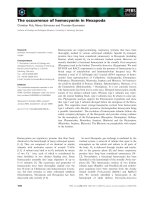
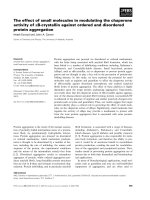
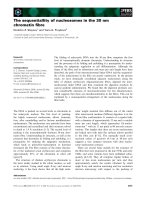
![Tài liệu Báo cáo khoa học: The stereochemistry of benzo[a]pyrene-2¢-deoxyguanosine adducts affects DNA methylation by SssI and HhaI DNA methyltransferases pptx](https://media.store123doc.com/images/document/14/br/gc/medium_Y97X8XlBli.jpg)
